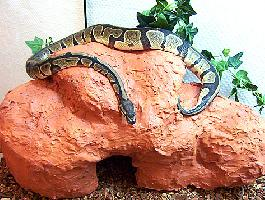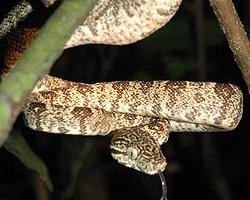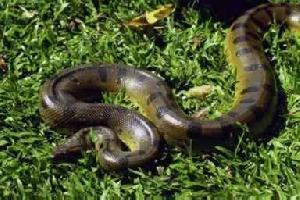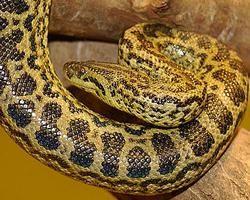
Váhy a míry
| Délka | od 1,2 do 1,3 m |
|---|
Popis zvířete
The Ball Python, scientifically known as Python regius, is a non-venomous constrictor species native to sub-Saharan Africa. This species has garnered immense popularity in the pet trade, thanks to its docile temperament, manageable size, and the vast array of stunning morphs that have been selectively bred over the years. Ball Pythons are named for their unique defensive behavior of coiling themselves into a tight ball when threatened, with their heads tucked securely in the middle.Adult Ball Pythons typically reach lengths of 4 to 5 feet (1.2 to 1.5 meters), making them a manageable size for most enthusiasts. Females are generally larger than males, a common trait among snakes. Their lifespan is notably long, with many individuals living over 20 years in captivity with proper care, emphasizing the commitment required to keep these animals as pets.
The natural habitat of the Ball Python is diverse, spanning grasslands, savannas, and sparse forests. They are ground-dwelling snakes but can occasionally be found in trees. In their native environments, Ball Pythons are nocturnal, spending the daytime hidden in burrows or other secluded places to escape the heat. At night, they emerge to hunt, relying on their keen senses to locate prey.
Diet-wise, Ball Pythons are carnivorous, feeding primarily on small mammals and birds in the wild. In captivity, they are usually fed a diet of appropriately sized rodents. Their method of hunting is by constriction; they strike to grasp the prey with their teeth, coil around it tightly until it suffocates, and then swallow it whole, head first.
One of the most fascinating aspects of Ball Pythons is their breeding and the resultant morphs—distinctive color and pattern variations. There are hundreds of recognized morphs, ranging from the striking Piebald, which has areas of unpigmented skin, to the vibrant Pastel, which enhances the snake's natural colors. These morphs have been selectively bred by enthusiasts, contributing to the species' popularity in the pet trade.
Breeding Ball Pythons can be a complex process, involving controlled temperatures and environments to mimic seasonal changes that trigger breeding behaviors. Females lay clutches of eggs, which they incubate by coiling around them and generating heat through muscle contractions. After an incubation period of around 60 days, the eggs hatch, revealing miniature versions of the adults.
In captivity, Ball Pythons require a well-structured habitat that mimics their natural environment to thrive. This includes a secure enclosure with appropriate temperature gradients, humidity levels, hiding spots, and a suitable substrate. Regular handling can help to maintain their docile nature, but it's crucial to respect the snake's boundaries and recognize signs of stress.
Conservation-wise, the Ball Python is listed as Least Concern by the IUCN Red List, but it faces threats from habitat destruction and the pet trade. While captive breeding has reduced the pressure on wild populations, illegal collection and habitat loss continue to pose risks. Conservation efforts and responsible pet ownership are vital to ensuring the future of this remarkable species.
In summary, the Ball Python is a fascinating creature that has captured the hearts of reptile enthusiasts around the world. Its manageable size, docile nature, and stunning variety make it a beloved pet, but it's important to remember the commitment and responsibility that come with owning such a long-lived creature. With proper care and respect for their natural behaviors, Ball Pythons can make rewarding companions for those willing to meet their needs.
Podobná zvířata
Nové fotografie zvířat
Top 10 zvířat
- Chinese water dragon (Physignathus cocincinus)
- Galápagos tortoise (Geochelone nigra complex)
- Dolphin gull (Leucophaeus scoresbii)
- Japanese macaque (Macaca fuscata)
- Colombian red howler (Alouatta seniculus)
- Sea urchins (Echinoidea)
- Diana monkey (Cercopithecus diana)
- Moustached guenon (Cercopithecus cephus)
- Colossal squid (Mesonychoteuthis hamiltoni)
- Common reed warbler (Acrocephalus scirpaceus)


